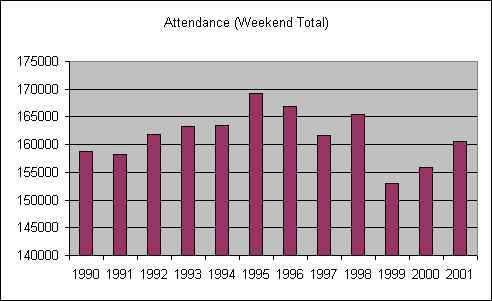

As an avid racing fan of all kinds, the presence of a major racing event such as a stop on the CART FedEx Championship Series in my own hometown is a big thing. I have attended the race numerous times, and try to watch every race throughout the season. I am what you'd call hard core. I know the rules, the drivers, the teams, the tracks, and even the technical jargon. Incorporating a hobby of mine with school makes it a lot more fun, and definitely more interesting. The final product may even be of use to CART and the people at Molson Indy.
The first step in preparing for this project was to get in contact with Stuart Ballantyne, the General Manager of the Molson Indy Vancouver. As it turns out, this was one of the more difficult tasks. He and his staff were on a break following the successful running of the 2001 Molson Indy Vancouver at Concord Pacific Place. After their return, he was out of town for year end meetings with CART officials in New York and Indianapolis. He also made a stop in Toronto to speak with Molson executives. When I finally spoke to him, the former SFU Grad welcomed me into his office. He offered sheets of statistics regarding both Canadian races (Toronto and Vancouver). Guidelines on course selection were described in full detail. Originally I had planned to examine the proposed track layouts in Surrey, but Stuart informed me that they were not available to the general public. Upon hearing this, I decided that it might be better for me to attempt to find sites that might even be more appropriate than those suggested by Ballantyne et al. He was very enthusiastic and said they would consider my analysis in their future plans. The factors and constraints used in my eventual spatial analysis were similar to those used by CART and other road racing organizations.
My goal in this project is to examine certain spatial data in order to determine possible locations for the troubled Molson Indy Vancouver. The recent development of numerous upscale apartment buidlings in the False Creek area has turned it into a residential area. A busy residential area is not the most desirable place to locate a racetrack, especially when the entrants are capable of exceeding 300 km/h. During past few years turmoil has arisen. Lobbying groups, residents, and most notably, developers have opposed the current track layout. They have quite successfully began a fight to push the Indy out of Vancouver. Ten years from now the race will almost surely be located elsewhere. Whether it will be in the Lower Mainland or in a city such as St. Louis or Brussels is of more importance.
The Vancouver Molson Indy brings a collosal amount of money into the city each year. Along with this financial growth, there is a positive atmosphere around False Creek. To many, the noise pollution of the weekend is too great a side effect of such a grand event. I, however, see that the benefits far outweigh the costs. The attendance figures below are very good when compared to others on the circuit. Vancouver, in fact, is third among all stops in average attendance. The significant drop in attendance in 1999 was because of the departure of Jacques Villneuve to Formula 1.

Please feel free to continue browsing through the project page.